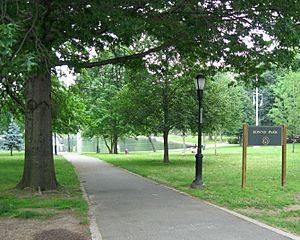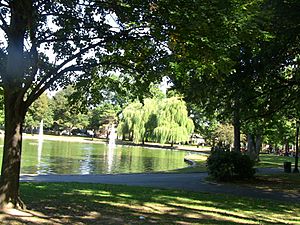Bowne Park facts for kids
Quick facts for kids Bowne Park |
|
|---|---|
 |
|
| Location | Broadway–Flushing, Queens, New York, US |
| Area | 11.79 acres (4.77 ha) |
| Created | 1925 or 1927 |
| Operated by | New York City Department of Parks and Recreation |
| Open | 6 a.m. to 1 a.m. |
| Status | open |
|
Bowne Park
|
|
|
U.S. Historic district
Contributing property |
|
| Location | Bounded by 29th Ave., 159th St., 32nd Ave., and 155th St., Flushing, New York |
| Built | 1925–1927 |
| Architectural style | Early and Mid-20th Century American Eclectic Period |
| Part of | Broadway–Flushing Historic District (ID06000373) |
| Added to NRHP | May 12, 2006 |
Bowne Park is a cool 11.79-acre park in Broadway–Flushing, Queens, New York. It's located just east of downtown Flushing. The park is surrounded by 29th Avenue, 32nd Avenue, 155th Street, and 159th Street.
In Bowne Park, you can find a fun playground, basketball courts, a bocce court, and a pretty kettle pond. The neighborhoods around the park, like Murray Hill and Broadway–Flushing, were also once called "Bowne Park" when they were first built.
The park is named after Walter Bowne, who was a mayor of New York City a long time ago. His summer home used to be right where the park is now. Sadly, it burned down in 1925. The city then bought the land and turned it into a park by 1927. Bowne Park was even home to New York City's very first modular playground, which opened in 1969. The park got a big makeover in 1994 and is looked after by the New York City Department of Parks and Recreation.
Contents
What Can You Do at Bowne Park?
Bowne Park covers about 11.79 acres and is a great place for people to gather. It's located in a part of Flushing that some people call Broadway–Flushing, Murray Hill, or even North Flushing. The homes around the park are mostly houses built in the 20th century. A local group called the Bowne Park Civic Association, started in 1979, helps take care of the park and its surrounding areas.
Explore the Kettle Pond
The western part of Bowne Park has a beautiful kettle pond. This oval-shaped fresh water pond is about 1 to 2 acres big. It has two fountains that help keep the water clean. The edge of the pond has a concrete wall, and there's a flagpole on the south side that looks like something you'd see at a marina.
The pond gets its water from the New York City water supply system now, but it used to be fed by a natural spring. You might spot turtles and fish in the pond. There's even a cool cement carving of a turtle! Look out for two tall, 50-foot weeping willows near the pond; they are very old.
Discover the Old Trees
The middle part of the park is like an old-growth forest. It has many large oak trees that have been there since the late 1800s or early 1900s. You can also find American elms in Bowne Park. There are benches and lights along the park's winding paths, making it a nice place to walk or relax.
Play and Relax
The eastern side of the park is where all the action is! It has a playground, a bocce court, and a basketball court. Near the play area, you'll find a building that looks like a Tudor-style house. This building has restrooms and storage rooms. It's made of brick and has a sloped roof and a chimney. Part of the building is also used as a children's nursery. There's even a weather vane on top of the roof!
How Bowne Park Came to Be
The Land's Early Days
Walter Bowne, who was the mayor of New York City from 1829 to 1833, built his summer home on this land in the early 1800s. His house was very large, with more than 15 rooms. By the late 1800s, the area around Walter Bowne's house started to be developed into a suburban neighborhood. People called it "Bowne Park" or "Murray Hill Park."
At first, not many houses were built there, even though a nearby train station was supposed to make travel to Manhattan easier. The land for the Bowne Park neighborhood was planned out by 1906. However, the Bowne house and the pond next to it remained untouched. The pond was a popular spot for ice skating in the winter.
In 1906, a company bought Walter Bowne's house and the large 195-acre Bowne Farm. Other companies later bought and developed the land around the house. The Bowne house itself was still occupied until 1923.
Creating the Park
On March 13, 1925, Walter Bowne's old house caught fire and burned down. The city then decided to turn the land into a park. Some records say the city officially took the land in June 1925, while others say it was bought in 1927. Even before it was officially bought, some advertisements mistakenly said the city already owned the land for a park.
During the Great Depression in the 1930s, a government program called the Works Progress Administration helped improve the park. They added paved paths and a concrete edge around the pond. Free plays were even held in the park in 1934. The park building, which you can still see today, was built in 1935.
Back then, Bowne Pond was a popular place for ice skating and boat races. One boat race in 1937 attracted 1,500 people, including the parks commissioner Robert Moses. After World War II, the stream that fed Bowne Pond was filled in.
Recent Years and Renovations
In the 1960s, there were plans to fix up the park, but they didn't happen right away. Then, in June 1969, Bowne Park got New York City's first modular playground, which had big fiberglass cubes. After a hurricane in 1968 knocked down many trees, a big renovation was planned for the park in the 1970s.
By that time, the park was a bit run down. The pond was being used as a dumping ground, and there was a lot of vandalism. During the renovation, some of the fish from Bowne Pond were moved to Flushing Meadows–Corona Park. The renovation was finished by 1975.
In 1994, the park received $800,000 for another big renovation. This project fixed up paths, cleaned the pond, and added new plants. However, in the years that followed, the pond sometimes had problems with too much algae. In 2002, the state gave money to help clean the pond again.
By the 2010s, people were still concerned about algae and trash in the pond. There were also floods and worries about missing fish and turtles. In 2011, two very old trees in the park were knocked down by Hurricane Irene. In 2014, officials announced $2.45 million for more park improvements, including the playground and pond. Work on the playground and basketball court started in 2016 and was finished in 2017.





